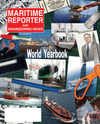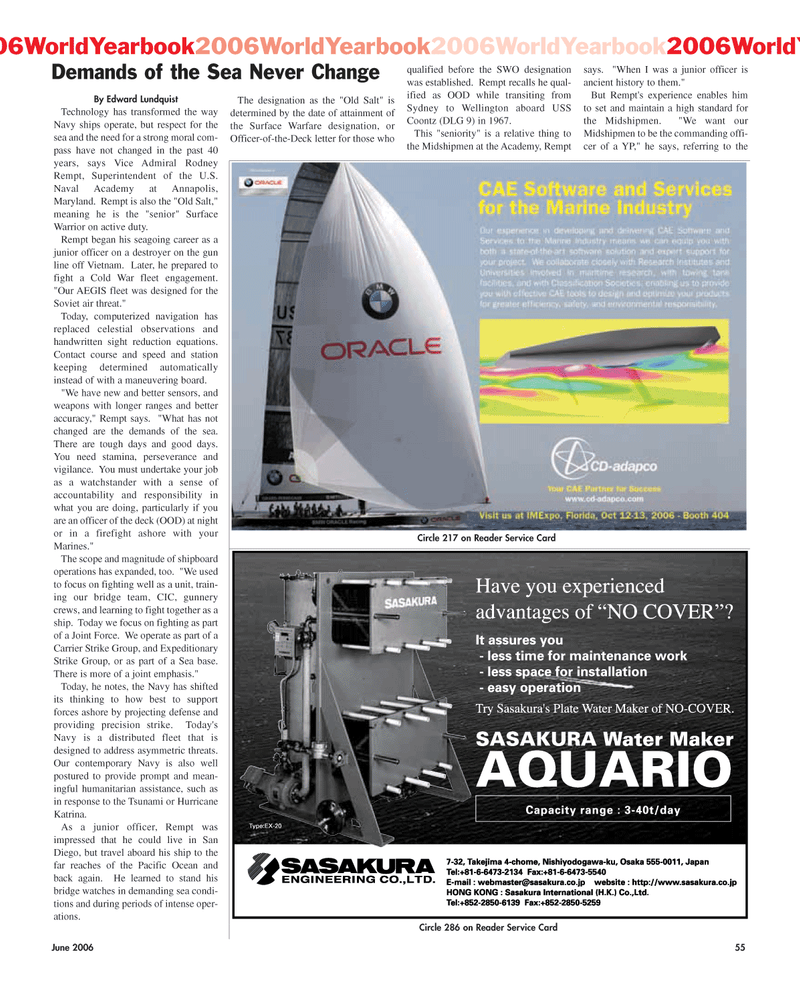
Page 55: of Maritime Reporter Magazine (June 2006)
Annual World Yearbook
Read this page in Pdf, Flash or Html5 edition of June 2006 Maritime Reporter Magazine
June 2006 55
By Edward Lundquist
Technology has transformed the way
Navy ships operate, but respect for the sea and the need for a strong moral com- pass have not changed in the past 40 years, says Vice Admiral Rodney
Rempt, Superintendent of the U.S.
Naval Academy at Annapolis,
Maryland. Rempt is also the "Old Salt," meaning he is the "senior" Surface
Warrior on active duty.
Rempt began his seagoing career as a junior officer on a destroyer on the gun line off Vietnam. Later, he prepared to fight a Cold War fleet engagement. "Our AEGIS fleet was designed for the
Soviet air threat."
Today, computerized navigation has replaced celestial observations and handwritten sight reduction equations.
Contact course and speed and station keeping determined automatically instead of with a maneuvering board. "We have new and better sensors, and weapons with longer ranges and better accuracy," Rempt says. "What has not changed are the demands of the sea.
There are tough days and good days.
You need stamina, perseverance and vigilance. You must undertake your job as a watchstander with a sense of accountability and responsibility in what you are doing, particularly if you are an officer of the deck (OOD) at night or in a firefight ashore with your
Marines."
The scope and magnitude of shipboard operations has expanded, too. "We used to focus on fighting well as a unit, train- ing our bridge team, CIC, gunnery crews, and learning to fight together as a ship. Today we focus on fighting as part of a Joint Force. We operate as part of a
Carrier Strike Group, and Expeditionary
Strike Group, or as part of a Sea base.
There is more of a joint emphasis."
Today, he notes, the Navy has shifted its thinking to how best to support forces ashore by projecting defense and providing precision strike. Today's
Navy is a distributed fleet that is designed to address asymmetric threats.
Our contemporary Navy is also well postured to provide prompt and mean- ingful humanitarian assistance, such as in response to the Tsunami or Hurricane
Katrina.
As a junior officer, Rempt was impressed that he could live in San
Diego, but travel aboard his ship to the far reaches of the Pacific Ocean and back again. He learned to stand his bridge watches in demanding sea condi- tions and during periods of intense oper- ations.
The designation as the "Old Salt" is determined by the date of attainment of the Surface Warfare designation, or
Officer-of-the-Deck letter for those who qualified before the SWO designation was established. Rempt recalls he qual- ified as OOD while transiting from
Sydney to Wellington aboard USS
Coontz (DLG 9) in 1967.
This "seniority" is a relative thing to the Midshipmen at the Academy, Rempt says. "When I was a junior officer is ancient history to them."
But Rempt's experience enables him to set and maintain a high standard for the Midshipmen. "We want our
Midshipmen to be the commanding offi- cer of a YP," he says, referring to the
Circle 217 on Reader Service Card
Circle 286 on Reader Service Card 2006WorldYearbook2006WorldYearbook2006WorldYearbook2006WorldY
Demands of the Sea Never Change
MR JUNE2006 #7 (49-56).qxd 6/2/2006 12:01 PM Page 55

 54
54

 56
56
